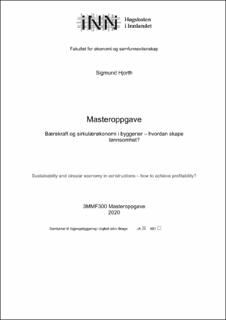| dc.contributor.author | Hjort, Sigmund | |
| dc.date.accessioned | 2021-08-10T11:09:03Z | |
| dc.date.available | 2021-08-10T11:09:03Z | |
| dc.date.issued | 2020 | |
| dc.identifier.uri | https://hdl.handle.net/11250/2767177 | |
| dc.description.abstract | Målet med denne masteravhandlingen er å identifisere lønnsomhet og verdiskapning i byggerier, og hvordan lønnsomhet kan skapes gjennom bærekraftig og sirkulærøkonomisk fokus. Forskningsprosjektet er begrenset til prosjekter i Norge. Det er gjennomført to casestudier innen bærekraft og sirkulærøkonomi vurdert ut ifra et aktør-nettverksperspektiv. Ett casestudie er gjennomført av et byggeri med fokus på bærekraft, Mjøstårnet – verdens høyeste trebygg, for å vurdere byggherres tilnærming til lønnsomhet, aktørenes påvirkning gjennom prosjektet og elementer av betydning for gjennomføringen. Det andre casestudiet er gjennomført med henblikk på å opparbeide erfaring fra et prosjektarbeid som er ferdigstilt i 2020. Prosjektet har hatt fokus på å fremme produkter som tjenester i et sirkulærøkonomisk perspektiv. Erfaringene fra dette prosjektet er knyttet opp mot barrierer, aktørenes påvirkning og virkemidler for å lykkes med en sirkulærøkonomisk tilnærming. Et viktig funn i oppgaven er knyttet til de ulike aktørene i verdikjeden innenfor byggebransjen, og deres aversjon for endring rettet mot bærekraftig utvikling og sirkulærøkonomi. Deres aversjon og hindringene dette medfører er sterkt sammenkoblet mellom alle aktørene i verdikjeden. Et annet interessant funn er det offentliges rolle som pådriver for endring. I tillegg; bransjens forståelse av lønnsomhet, krever en tydelig endring for å kunne tilnærme seg bærekraftig utvikling og sirkulærøkonomi. | en_US |
| dc.description.abstract | Abstract
The aim of this master thesis is to identify profitability and creation of value in constructions, and how profitability can be achieved in projects with focus towards sustainable and circular economy. The research project is limited to projects in Norway. Two case studies have been performed in terms of sustainability and circular economy with an actor-network perspective. One of the case studies is performed based on the construction of a new building with sustainable focus, Mjøstårnet – the world´s tallest wooden building, to analyze the builder´s approach for profitability, the influence of different construction roles throughout the project and the factors which affected the process. The second case is performed to gather information and knowledge from a project finalized in year 2020, to promote products as services in a circular economic perspective. The project group summarized their work in a framework called “leietid” (rental time). Important knowledge from the case study is associated with barriers, influence of actors and measurement parameters on how to succeed with circular economic implementation. An important finding from both of the cases studies, is associated with the perceptions and attitude of the different construction actors in the value chain towards change needed to achieve sustainable development and circular economy. Furtherhow constraints, obstacles and barriers are connected within all actors of the value chain. Another interesting finding is the government’s role as an influencer for change. Finally, how profitability is measured needs to change in order for the whole property and construction industry to achieve sustainability and circular economy. | en_US |
| dc.language.iso | nob | en_US |
| dc.subject | kasus-studie | en_US |
| dc.subject | Case Study | en_US |
| dc.subject | kvalitativ metode | en_US |
| dc.subject | Qualitative Method | en_US |
| dc.subject | sirkulærøkonomi | en_US |
| dc.subject | Circular Economy | en_US |
| dc.title | Bærekraft og sirkulærøkonomi i byggerier – hvordan skape lønnsomhet? | en_US |
| dc.title.alternative | Sustainabilty and circular economy in constructions – how to achieve profitability? | en_US |
| dc.type | Master thesis | en_US |
| dc.subject.nsi | VDP::Samfunnsvitenskap: 200::Økonomi: 210::Samfunnsøkonomi: 212 | en_US |
| dc.source.pagenumber | 91 | en_US |
